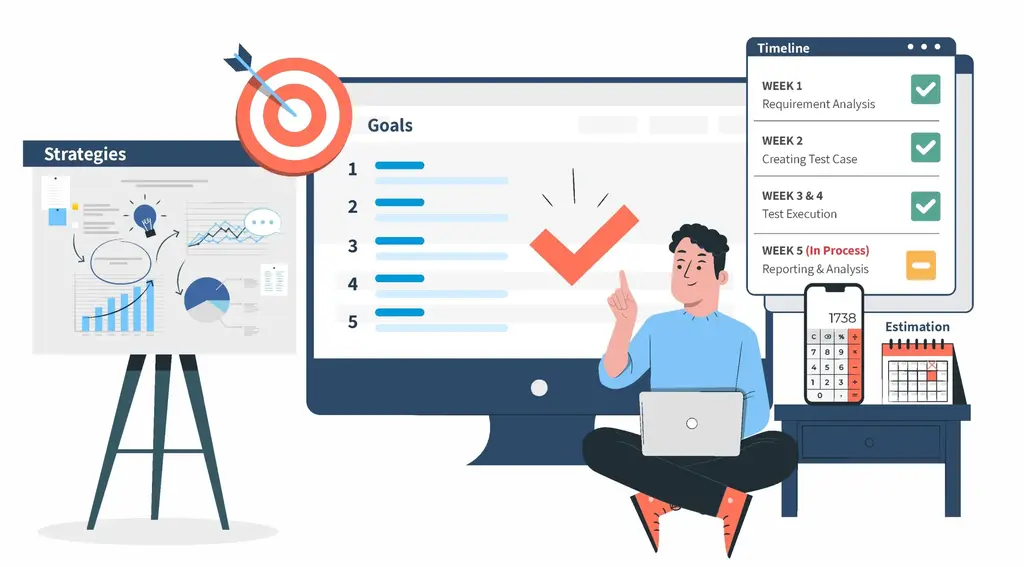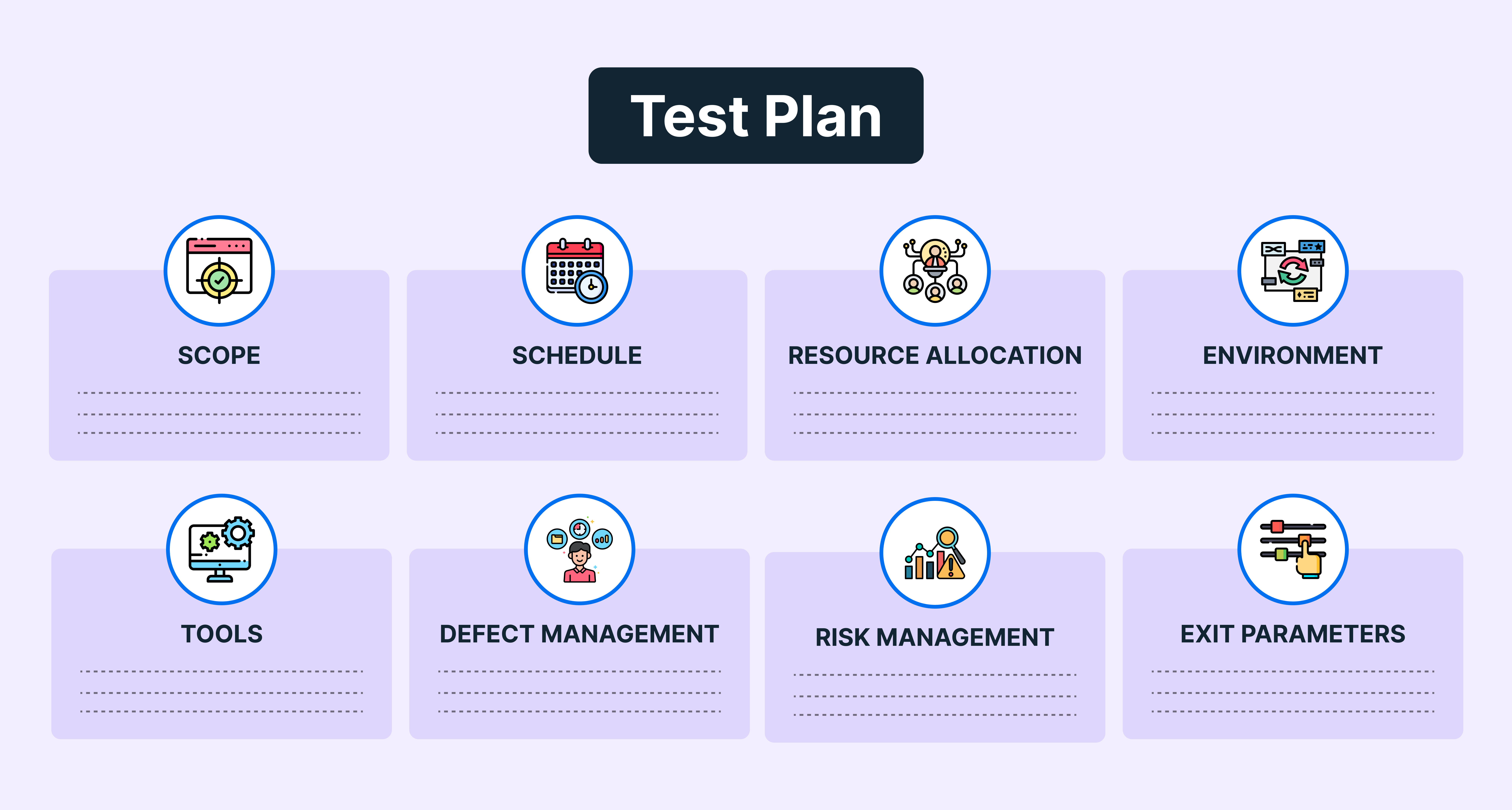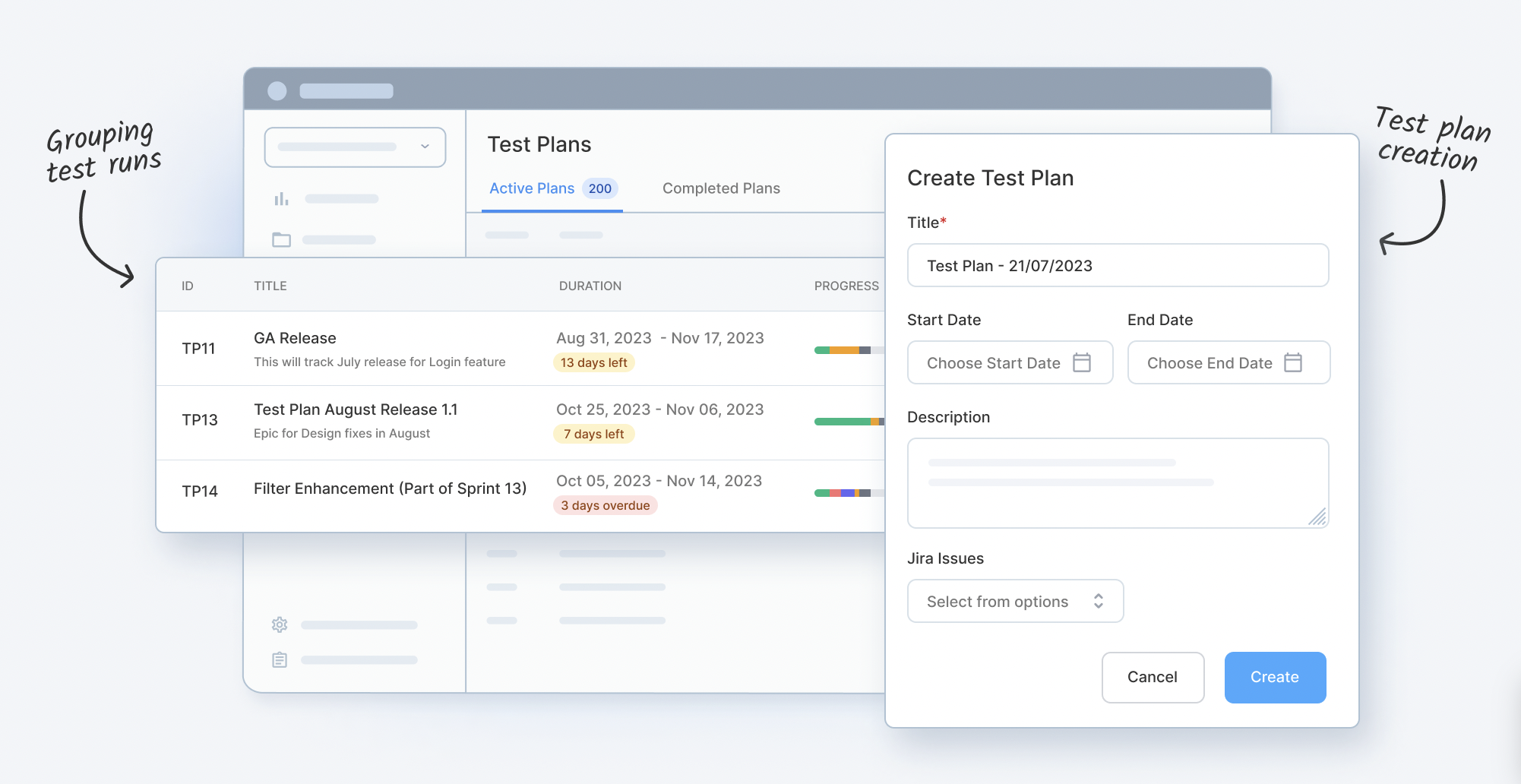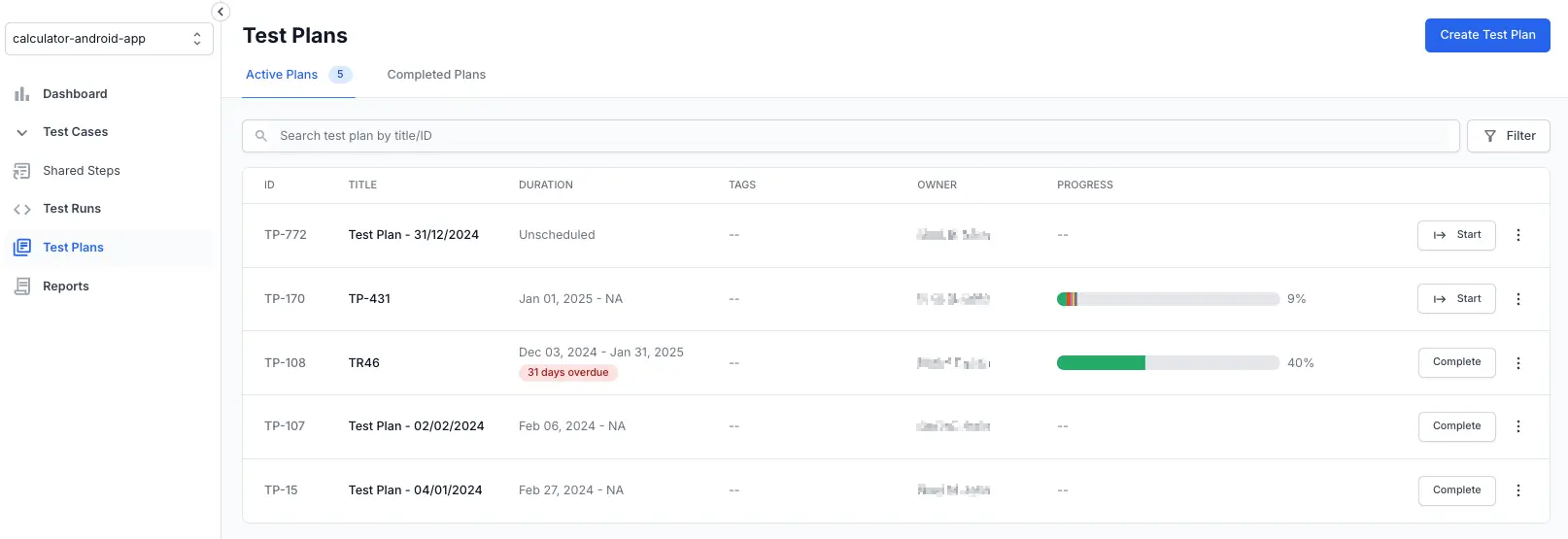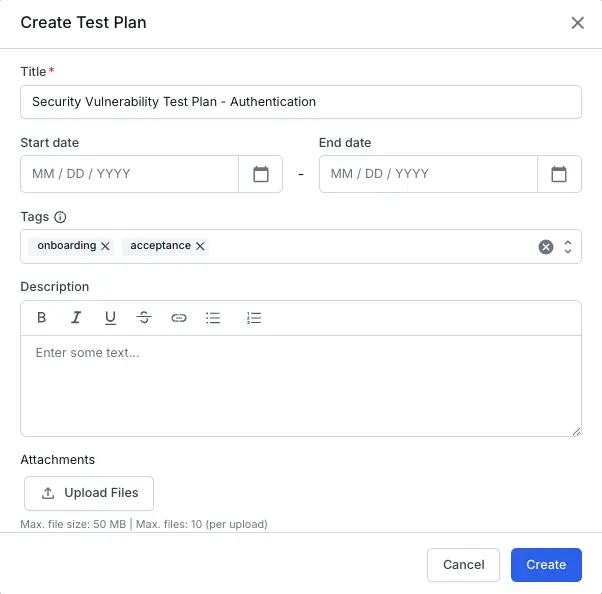What is Test Plan?
What is a Test Plan?
Test Plan is a detailed document that outlines the Objective, strategies, timeline, goals, estimation, deadlines, and resources needed for the successful completion of a project. It provides a framework that is designed by QA managers to provide clarity about the necessary tests that you need to verify to ensure the proper functioning of the software.
Why is a Test Plan Important?
A test plan organizes the entire testing process by outlining what needs to be tested, how testing will be conducted, and who is responsible for each task. This helps avoid confusion, reduces rework, and ensures that all requirements are addressed systematically.
Here are the reasons why it is important to create a test plan:
You can eliminate 1/3 of the cost with improved testing infrastructure and planning. Even though it may not be able to eliminate all errors cannot be eliminated through.
- Reduced defects: Identify and mitigate defects early on in the software lifecycle.
- Improved quality: Projects with thorough test plans often reduce development and maintenance costs by catching issues early, when fixes are faster and less expensive than post-release corrections.
- Resource utilization: A test plan helps allocate resources effectively, avoid bottlenecks, and ensure smooth test execution.
- Faster time to market: A well-defined testing plan accelerates development by guiding efficient testing and helping teams release software faster.
Components of a Test Plan
A test plan usually comprises various elements that offer in-depth details regarding the testing procedures for a particular software application or system.
The essential components of a test plan include:
- Scope: Outlines the goals of the specific project and provides information about user scenarios intended for testing purposes. The scope may also specify scenarios or issues that will not be addressed by the project if required.
- Schedule: Specifies the commencement dates and deadlines for testers to provide outcomes.
- Resource Allocation: Specifies the allocation of specific tests to individual testers.
- Environment: Describes the characteristics, setup, and accessibility of the test environment.
- Tools: Specifies the tools that will be employed for testing, reporting bugs, and other pertinent activities.
- Defect Management: Outlines the procedure for reporting bugs, including the designated recipients and the required accompanying elements for each bug report. This may include specifications such as whether bugs should be reported with screenshots, textual logs, or videos demonstrating their occurrence in the code.
- Risk Management: Specifies potential risks that could arise during the testing of the software and the risks the software might face if released without adequate testing.
- Exit Parameters: Specifies the cessation point for testing activities. This section delineates anticipated outcomes from QA operations, providing testers with a standard against which they can measure actual results.
Who needs Test Planning?
Test plan is an important artifact which, when well drafted, can act as an anchor for the product development process. However, these personas benefit more from its creation.
- Developers, who get insights into the testing scope and requirements. This helps them anticipate the tests that will be executed on their code and understand the success criteria for testing.
- QAs, who create and execute test cases to find bugs and document them. Test planning helps them establish testing strategies, allocate resources, and track the overall advancement of the testing process. Test Plan functions as a roadmap for carrying out test cases, monitoring test advancement, and guaranteeing thorough coverage.
- Product Managers, who use test plans to make informed decisions about release timelines, resource allocation, and overall product quality. It helps them coordinate release activities, assess customer impact, and foster effective collaboration between development and testing teams to deliver high-quality software.
- Business Analysts, who ensure all the test cases are well aligned with the business requirements specs at every stage, keeping users’ interests in mind. Through test planning, they get a clear vision of the relevance of test cases with current user requirements.
- Compliance Teams, ensure that the testing procedures conform to predefined standards as per regulatory demands.
- Support Teams, who communicate with users about known issues, provide timely solutions and offer guidance on workarounds. Test Plans help them anticipate potential issues or bugs that have been identified during the testing phase and figure out their workarounds to help users.
Learn More about Test Management
Difference between Test Strategy and Test Plan
A test strategy is a high-level outline that provides an approach and framework for testing. A test plan is a detailed document that provides guidance around specific test activities, scope, deliverables, and resource projections for the project.
Here’s a detailed comparison of Test Strategy vs Test Plan:
| Aspect | Test Plan | Test Strategy |
|---|---|---|
| Definition | Comprehensive details regarding testing goals, levels, categories, outputs, timetable, resources, roles, duties, risk management, and criteria for completion. | General details concerning testing goals, levels, categories, tools, defect management, and the overarching testing strategy. |
| Scope | Thorough, encompassing all aspects of the testing process for a particular project or application. | Extensive, furnishing a structure for testing tasks spanning numerous projects or applications. |
| Audience | Testing team members, testing managers, developers, project managers, and additional stakeholders engaged in the particular project. | Managers overseeing projects, testing managers, and individuals making decisions requiring a summary of the overarching testing strategy. |
| Granularity | More specific, concentrating on the implementation of testing tasks within a designated project or application. | Less intricate, providing a broad viewpoint and directing the development of detailed test plans. |
| Timeline | Usually generated subsequent to the test strategy, outlining precise schedules for testing stages and tasks. | Developed at the outset of the project lifecycle, furnishing an outline before in-depth test planning. |
| Changes | Prone to modifications throughout the project as additional detailed information is acquired or if project requirements undergo changes. | Typically steady and undergoes infrequent alterations unless there are substantial shifts in project scope or objectives. |
How to create a Test Plan?
Follow these steps to create an effective and actionable test plan document.
Step 1: Understand the System Under Test (SUT)
The System Under Test (SUT) refers to the complete software product or component being validated. It is important to understand the application’s architecture, expected behavior, and interaction points to design relevant tests, identify key functionalities, and anticipate integration challenges.
- Analyze functional requirements and technical specifications
- Review architectural diagrams and data flow between modules
- Identify all inputs, outputs, and user interaction points
- Understand third-party integrations and dependencies
- Clarify expected behavior across different platforms or user roles
Step 2: Define the Scope and Objectives
Scope defines what will be tested and what will be left out, while objectives clarify what QA aims to achieve during the cycle based on the release type and product maturity. Here’s how to define the scope and objectives when creating a testing plan.
- Identify testable modules, supported platforms, and environment types
- Exclude non-priority features or known unstable areas if needed
- Map objectives to specific goals like regression depth or release readiness
- Align scope with risk areas or high-traffic user journeys
Step 3: Identify Risks, Assumptions, and Preconditions
Every test cycle depends on certain conditions, operates under specific assumptions, and faces potential risks. Documenting tests early helps prevent surprises and gives stakeholders full visibility into dependencies. Follow these best practices when creating a test plan document.
- List risks such as incomplete features, unstable environments, or late builds
- Capture assumptions like the availability of test data, tools, or final APIs
- Document preconditions, including setup steps, user roles, or backend configurations
- Prioritize risks based on likelihood and impact to test timelines
- Identify mitigation actions for each critical risk scenario
Step 4: Design the Test Strategy
A test strategy outlines the overall testing approach, combining test types, coverage goals, and execution methods. This ensures consistency across different test efforts. Here’s how to create a test strategy.
- Choose which test types to include (for example, smoke testing, regression testing, or exploratory testing)
- Decide between manual vs. automated testing for each area.
- Set entry and exit criteria for different phases
- Finalize tools for test management, automation, and reporting
Step 5: Determine Test Deliverables
Test deliverables include test cases, traceability matrices, execution reports, and defect logs. These documents test coverage, support release readiness, and ensure accountability across the QA cycle. Here’s how to determine test deliverables.
- Define all planned test artifacts, such as test plans, test cases, and test scripts
- Specify reporting assets, including daily status updates, defect summaries, and test execution reports
- Include traceability matrices to map test cases to requirements or user stories
- Identify sign-off documents needed for each test phase
- Align deliverables with compliance or audit needs, if applicable
Step 6: Set Up the Test Environment and Test Data
The test environment mirrors the production setup to validate system behavior accurately. Well-structured and relevant test data ensures that test coverage aligns with real-world usage.
Here’s how to set up the test environment for test planning.
- Define infrastructure needs such as OS, browsers, mobile devices, or cloud setup
- Configure test environments to match production in terms of integrations, services, and network access
- Prepare test data sets for positive, negative, edge, and boundary scenarios
- Use data masking or anonymization techniques for privacy and compliance when using real user data
- Automate environment provisioning and data refresh where possible to reduce setup time
Step 7: Allocate Resources and Responsibilities
Define roles, responsibilities, and timelines for each activity in the QA cycle to improve accountability, minimize overlap, and avoid resource bottlenecks. Follow these tips when allocating resources and responsibilities.
- Assign ownership for tasks like test case creation, automation development, execution, and reporting
- Estimate effort for each phase and align it with team capacity and timelines
- Include contingency plans for resource unavailability or skill gaps
- Define escalation paths for blockers or high-priority defects
Step 8: Develop the Test Schedule
A test schedule defines the timeline for all testing activities and aligns it with development milestones and release deadlines.
Follow these tips to create an effective test schedule.
- Break down test phases with start and end dates
- Add time buffers for bug fixes, retesting, and environment issues
- Align testing milestones with development sprints or release windows
- Track dependencies like environment readiness or third-party system availability
- Use Gantt charts or task boards for visibility and progress tracking
One Page Test plan
This one-page template outlines key test planning elements in a clear, easy-to-share format. Use it to define scope, align teams, and track progress.
| Section | Details |
| Test Plan Title | Module or Feature Name – Platform/Version |
| Prepared By | Name of the person preparing the test plan |
| 1. Introduction | Brief summary of what is being tested and the purpose of this test plan |
| 2. Testing Resources | Name and role of each tester involved in the test effort |
| 3. Scope of Testing | In Scope: Features/modules covered Out of Scope: Features/modules excluded |
| 4. Test Items | Specific flows, APIs, or components being tested |
| 5. Testing Approach | Methodology used (manual, automation, or both) Types of testing: functional, UI, performance, security, accessibility |
| 6. Test Environment | Devices, OS versions, tools, emulators/simulators, and any required setup |
| 7. Test Schedule | Define timeframes for planning, execution, defect resolution, and reporting |
| 8. Entry & Exit Criteria | Entry Criteria: Start the test when the environment is set up, the build is stable, and the necessary test data is ready for execution. Exit Criteria: End the test when all critical issues are resolved, required test coverage is achieved, and the test results are reviewed and approved. |
| 9. Risks & Mitigation | List key risks or blockers and create contingency plans |
| 10. Deliverables | Test cases, defect reports, execution logs, final summary report |
How To Deal With Changes to the Test Plan
Test plans often evolve due to shifting requirements, design changes, scope adjustments, or external dependencies. Effectively handling these changes requires built-in flexibility, documented procedures, and clear communication.
- Establish a change control process: Define a formal review and approval workflow for any test plan modifications. Before implementation, relevant stakeholders should assess the impact of the changes and approve them.
- Assess the impact across all areas: Evaluate how a change affects the test scope, objectives, test cases, timelines, resource availability, and risk profile. Update traceability matrices and coverage metrics accordingly.
- Communicate updates transparently: Notify all affected teams, including developers, product owners, and business stakeholders. Ensure everyone is aligned on what has changed and why, along with the downstream effects.
- Update deliverables and documentation: Revise all related test artifacts, such as test cases, schedules, and environment configurations. Ensure version control is maintained to track what was changed and when.
- Reprioritize testing activities: If timelines or scope change, adjust the testing plan based on risk, business impact, and feature readiness. Consider cutting or deferring low-priority tests if necessary.
Incorporating Advanced Test Strategies (With Examples)
Advanced strategies like shift-left and shift-right testing help integrate quality checks earlier and later in the pipeline. This ensures faster feedback and more reliable releases.
Shift-Left Testing
Shift-left testing moves quality checks to earlier phases of development. Its goal is to catch defects during planning, design, and coding to reduce costs and prevent delays.
To apply shift-left testing effectively, teams should:
- Define acceptance criteria during backlog refinement
- Conduct static code analysis before runtime
- Implement unit tests and API tests alongside feature development
- Integrate automated tests within CI/CD pipelines
For example, the QA team validates acceptance criteria during user story creation. Developers write unit tests and trigger them automatically with every code commit. This helps identify logical errors early before reaching integration testing or system testing.
Shift-Right Testing
Shift-right testing extends QA efforts into the post-deployment phase. It focuses on real-world validation by testing in production-like environments using actual user behavior and operational conditions.
To apply shift-right testing effectively, teams should:
- Deploy features incrementally using canary releases or toggles
- Run synthetic monitoring tests in production
- Apply A/B testing to observe real user impact
- Use telemetry and analytics to detect and assess issues
For example, a feature is gradually rolled out to a limited user group using a toggle. Synthetic monitoring and behavioral analytics track system performance, while insights from this data help adjust the rollout or uncover issues missed in earlier testing.
Best Practices for creating an effective Test Plan
Some of the key best practices for creating effective test plan are:
- Understand project requirements and map to test cases.
- Clearly state the objectives of the testing effort.
- Clearly define the scope of testing, outlining which features and functionalities will be tested.
- Document the expected deliverables of the testing process.
- Define the test environment, detailing the hardware, software, and network configurations.
- Identify potential risks associated with the testing process and the project.
- Create a detailed testing schedule with milestones and deadlines.
- Create a realistic and achievable testing schedule.
- Maintain flexibility to tweak the plan, if required.
- Include scope for retrospection and avoid pitfalls in the future.
- Define key metrics to be collected during testing.
- Conduct retrospectives to identify areas for improvement in the testing process.
Test Planning With a Test Management Tool
Test management tools provide an organized view of test cases and a clear path for execution. BrowserStack Test Management helps teams define, track, and run tests from a centralized platform, streamlining the test planning process.
How BrowserStack Test Management Enhances Test Planning:
- AI-Powered Test Case Creation: Automatically generates comprehensive test cases from Product Requirement Documents (PRDs), user stories, or text prompts. AI also suggests enhancements to existing test cases, significantly reducing manual effort.
- Real-Time Insights: Track key metrics such as automation coverage and test outcomes with customizable dashboards. Monitor trends and the status of releases, providing insights to keep testing on track.
- Automation Integration: Easily integrates with CI/CD pipelines to trigger test runs automatically, ensuring seamless integration into the development workflow.
- Low-Code Automated Test Authoring: Quickly converts manual test cases into low-code automated tests by scanning descriptions and auto-filling script steps, speeding up automation adoption.
- Bulk Actions: Simplifies test case management with features like bulk edit, copy, move, and delete. Quickly sort, filter, and search test cases using predefined parameters.
Here’s how to create and manage test plan documents with a test management tool like BrowserStack.
- On the left navigation section, click Test Plans.
- Within the Test Plans dashboard, click the Create Test Plan button.
- Enter information about Test Plan like start and end date, description, and Jira issues, and click Create.
Conclusion
A strong test plan document ensures that testing aligns with business goals and that teams are prepared to handle risk, prioritize tasks, and validate functionality across environments. It helps QA teams organize coverage, developers align testing with code changes, and product managers and stakeholders track progress and assess release readiness.
BrowserStack Test Management simplifies test planning by combining AI-powered test creation, low-code automation, and detailed reporting in a single platform. It supports test case imports, integrates with bug-tracking tools, and runs tests across real devices, browsers, and operating systems.
